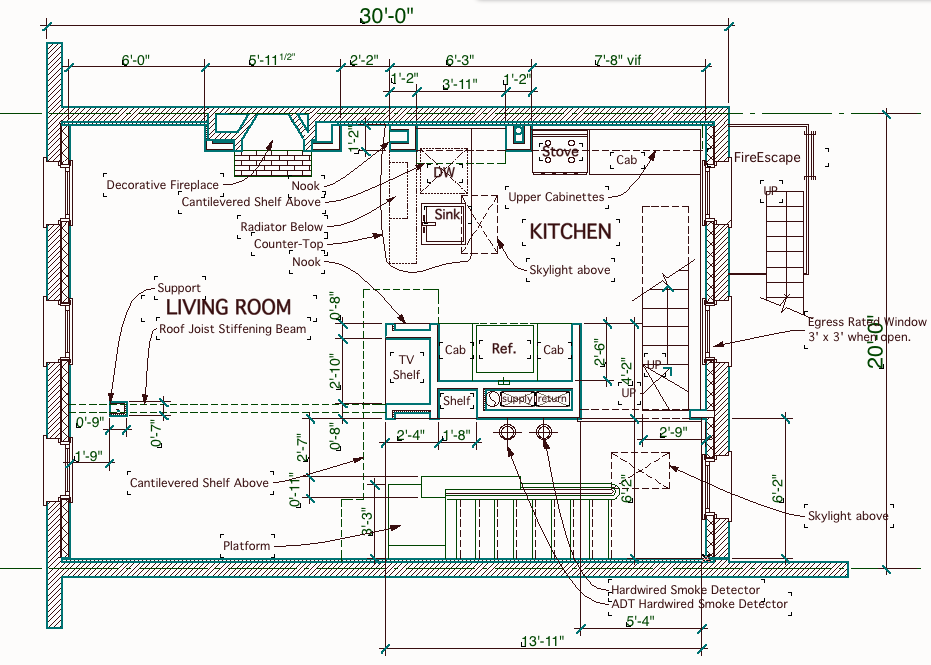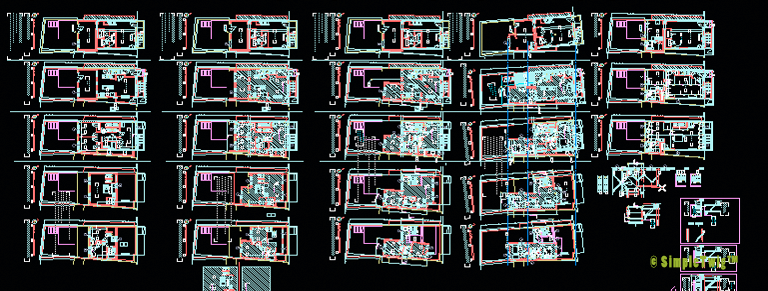hierarchy |ˈhī(ə)ˌrärkē|noun ( pl. -chies)a system or organization in which people or groups are ranked one above the other according to status or authority.

When renovating urban townhouses, it’s important when laying out the rooms that one takes into consideration the hierarchy of those rooms. It sounds simple, some rooms are larger than others, but I have seen enough clients to know that some people will insist on certain things, like a huge Master Suite that leaves their living room tiny. Well, that to you might seem obvious, but to some home owners they will put the wrong priorities in front of the obvious.
I had one client who was convinced that having the living room on the Parlor Floor was the right thing to do in one particular townhouse, even though the top floor allowed the living room to be 6 feet wider and 6 feet longer. This was because the top floor didn’t have to accommodate the townhouse entrance/vestibule and the main stair (longer because of the floor to floor height), both which occupied a lot of space. The result was a very small living room and a Master Suite that was larger which is fine if you plan on entertaining guests in your bedroom.
In another townhouse that had a larger floor plate than the above example, the client insisted that the living room and kitchen be placed on the basement level. In their townhouse the basement level had very low ceilings, and the living room had to accommodate the townhouse entrance and stair, making it very small (located near the front of the house) where, if they put the living/kitchen on the parlor floor (that had high ceilings and plenty of light), the Living room could of been around 18’x25′ with a view of their rear yard off a new deck. The result as built was a dark and small living room (12’x14′), and on their parlor floor a huge master bedroom that was so large it had it’s own mini-living room. In that townhouse the master bedroom should of gone upstair with the other bedrooms and the basement should of been a family room to accommodate the owner’s 3 children. After spending nearly a million dollars for a renovation it’s painful to me when clients insist on the wrong solution as I know they will have to live with it for many decades to come.
So what is a good rule to follow when determining room sizes? Well if you simply rank each room’s size, from largest to smallest given the following list, you will end up with something that makes sense.
Living Room (this is the room where people spend their most ‘day’ time)
Kitchen (in some cases this can be a lot smaller and integrated into the Living area).
Master Bedroom (bedrooms are places to sleep for the most part and thus are not for social entertaining or other ‘day time’ functions)
Bedroom(s) (should have room for at least 2 potential locations for a queen sized bed, and room for dressers and a desk).
Master Bathroom
Bathroom(s) (should be larger than what is required by code. It is important that these are large enough to make effeciency possible without it becoming cluttered with personal items)
Walk-in Closets (whenever these can be accommodated, have them)
Closets (without closets, a residence is not a functioning home).
Within this it is always important to minimize circulation spaces like hallways. Why use up your square footage with a hallway that is too large when a well designed layout can minimize the size of a hallway giving the saved space to other rooms? In this aspect one can always spot an experienced Architect versus someone who hasn’t mastered the fundamentals of architectural design.
It’s all a matter of hierarchy. Finding the right solution given the context and keeping one’s priorities in the right place. For me as a designer I always keep those rules in the back of my mind as I refine a design. The right and best solution is never easy to accomplish and most won’t appreciate the effort that has been put into a project, except when they walk through it. In the above plan I always get compliments on the space as it is unexpected given the footprint size of 20’x30′. In that project the best location for the living portion of that townhouse was on the top floor. For it, not only did I accomplish large living spaces, but added with the cool breezes and extra light from being higher off the street there is a real sense of privacy and specialness to the space. In projects that have failed to acknowledge the fundamentals of hierarchy, the comments are more like ‘why did they choose to do it that way?’
As an Architect I can never force a client to take my advice, but if they are heading in the wrong direction I will state that ‘I strongly advise against doing what they are suggesting’ and state why. When confronted by a client that says ‘I’ve already made a decisions on that and that’s how I want it’ I say to myself there is nothing else I can do, and their apparent lack of respect for the profession or my advice will result in something I hope they are happy with. Never the less, when these rare circumstances do arise, they leave me without a project I can add to my portfolio or one in which photographing the details, and not the overall appearance, is all the is left as an option.
In the end it is your money, and thus you have the right to decide what is built. But perhaps your most important decision will be: “I trust my Architect’s recommendations based on what he/she has explained to me” keeping in mind the fundamental hierarchical relationships all homes should attain.
Don’t forget to subscribe to our blog (top right side). Thank you.

